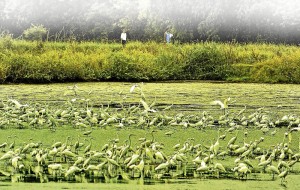Birds flock anew to mangrove haven

THE BANGRIN Marine Protected Area, which is home to migratory birds and a healthy mangrove forest, has become a source of pride for residents of Bani, Pangasinan. EV ESPIRITU
In the middle of Tambac Bay, an estuary where at least nine rivers meet, is a lush mangrove forest where migratory and local birds fly free and marine life thrives.
It would be hard to imagine when only more than 20 years ago, the river was barren, without mangrove trees that used to flourish in the area. The town’s mangrove forests were destroyed to give way to fishpond development in the area.
“The town used to have around 2,000 hectares of mangrove forests. At the end of the 1980s, only a hectare was left,” says Mayor Marcelo Navarro Jr.
But his father, the late Mayor Marcelo Navarro Sr., was decided to revive the town’s mangrove paradise.
Thus the Bangrin Marine Protected Area (MPA) was established in 1990, when the local government entered into a three-year community contract with the Department of Environment and Natural Resources (DENR), for an integrated mangrove rehabilitation project. It is comanaged by the local government and the fishermen of Aporao and San Miguel villages.
Article continues after this advertisementSome 20 years later, the elder Navarro’s dream has become a pride of the town. The 42-ha Bangrin MPA bagged the second prize in the Para del Mar award as the country’s outstanding MPA in 2011. The award is given by the MPA Support Network (MSN), a multisectoral group that supports marine protected areas.
Article continues after this advertisementThe Para del Mar (For the Sea) award recognizes the outstanding management practices of MPAs in the country, including the extent of community involvement, the degree of local government and community comanagement, the enforcement of environmental laws and the participation of other stakeholders.
The top prize went to Bangaan Marine Sanctuary in Tungawan, Zamboanga Sibugay, an 880-ha area of coral reef, sea grass beds and mangroves.
Navarro says his father would have been very happy for the achievement, the first national award earned by the Bangrin MPA. In 1996, it bagged the Likas Yaman award given by the DENR.
Tourist attraction
According to Navarro, the MPA is fast becoming a tourist attraction of the town. It is identified in the book, “Bird Watching in the Philippines,” as one of the 13 best sites for bird watching in the country.
Bangrin’s mangrove forest is home to 21 species of shellfish, nine species of fish and 57 species of birds.
Navarro says the plan is to designate a spot in the MPA as a bird park where a board walk will be placed for bird watchers and visitors.
At least three cottages will be put up so visitors will have a place to stay as they watch birds in the late afternoon and early morning.
There is a board walk around the MPA where visitors may view the forests and the birds. They may also paddle boats to go deeper into the mangrove forest.
A pair of Bantay Dagat (sea guards) is assigned to patrol the forest 24-hours daily. A coast watch station has been put up to guard the forest from illegal activities. Fishing is strictly prohibited inside the protected area.
But the MPA has not been immune from environmental degradation, which could be caused by the erratic weather and pollution from aquaculture operations in nearby towns.
Jimuel Figuracion, a Bantay Dagat, says a variety of algae has been proliferating in the past years. “This type of algae, which looks like a green mosquito net, usually grows during the rainy months when the water is fresh and dies when the sea water enters. But we have noticed that through the years, they have become thicker,” he says.
The variety is different from the one fed to bangus (milkfish) in some towns. “This kind is thick and the bangus can’t eat it,” he says. It entangles the newly planted mangrove seedlings or traps and kills oysters.
Despite these problems, local officials and residents are firm in keeping Bangrin healthy and protected because it symbolizes their unity and fulfillment of their dreams.